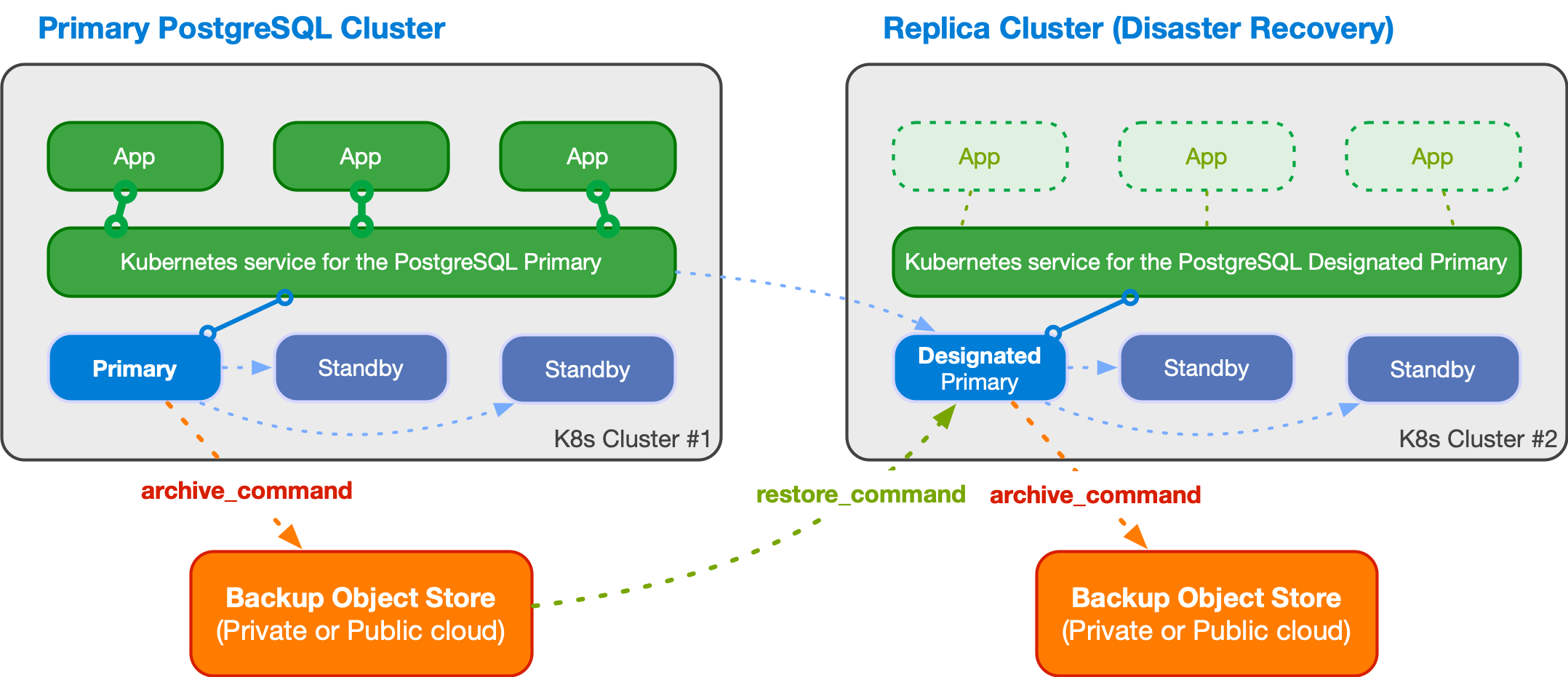Replica clusters
A replica cluster is an independent CloudNativePG Cluster resource that has
the main characteristic to be in replica from another Postgres instance,
ideally also managed by CloudNativePG. Normally, a replica cluster is in another
Kubernetes cluster in another region. Replica clusters can be cascading too,
and they can solely rely on object stores for replication of the data from
the source, as described further down.
The diagram below - taken from the "Architecture" section containing more information about this capability - shows just an example of architecture that you can implement with replica clusters.

Basic concepts
CloudNativePG relies on the foundations of the PostgreSQL replication framework even when a PostgreSQL cluster is created from an existing one (source) and kept synchronized through the replica cluster feature. The source can be a primary cluster or another replica cluster (cascading replica cluster).
The available options in terms of replication, both at bootstrap and continuous recovery level, are:
- use streaming replication between the replica cluster and the source (this will certainly require some administrative and security related work to be done to make sure that the network connection between the two clusters are correctly setup)
- use a Barman Cloud object store for recovery of the base backups and
the WAL files that are regularly shipped from the source to the object
store and pulled by
barman-cloud-wal-restorein the replica cluster - any of the two
All you have to do is actually define an external cluster.
Please refer to the "Bootstrap" section
for information on how to clone a PostgreSQL server using either
pg_basebackup (streaming) or recovery (object store).
If the external cluster contains a barmanObjectStore section:
- you'll be able to bootstrap the replica cluster from an object store
using the
recoverysection - CloudNativePG will automatically set the
restore_commandin the designated primary instance
If the external cluster contains a connectionParameters section:
- you'll be able to bootstrap the replica cluster via streaming replication
using the
pg_basebackupsection - CloudNativePG will automatically set the
primary_conninfooption in the designated primary instance, so that a WAL receiver process is started to connect to the source cluster and receive data
The created replica cluster can perform backups in a reserved object store from the designated primary, enabling symmetric architectures in a distributed fashion.
You have full flexibility and freedom to decide your favorite distributed architecture for a PostgreSQL database by choosing:
- a private cloud spanning over multiple Kubernetes clusters in different data centers
- a public cloud spanning over multiple Kubernetes clusters in different regions
- a mix of the previous two (hybrid)
- a public cloud spanning over multiple Kubernetes clusters in different regions and on different Cloud Service Providers
Setting up a replica cluster
To set up a replica cluster from a source cluster, we need to create a cluster YAML file and define the following parts accordingly:
- define the
externalClusterssection in the replica cluster - define the bootstrap part for the replica cluster. We can either bootstrap via
streaming using the
pg_basebackupsection, or bootstrap from an object store using therecoverysection - define the continuous recovery part (
spec.replica) in the replica cluster. All we need to do is to enable the replica mode through optionspec.replica.enabledand set theexternalClustersname in optionspec.replica.source
This first example defines a replica cluster using streaming replication in both bootstrap and continuous recovery. The replica cluster connects to the source cluster using TLS authentication.
You can check the sample YAML
in the samples/ subdirectory.
Note the bootstrap and replica sections pointing to the source cluster.
bootstrap:
pg_basebackup:
source: cluster-example
replica:
enabled: true
source: cluster-example
In the externalClusters section, remember to use the right namespace for the
host in the connectionParameters sub-section.
The -replication and -ca secrets should have been copied over if necessary,
in case the replica cluster is in a separate namespace.
externalClusters:
- name: <MAIN-CLUSTER>
connectionParameters:
host: <MAIN-CLUSTER>-rw.<NAMESPACE>.svc
user: streaming_replica
sslmode: verify-full
dbname: postgres
sslKey:
name: <MAIN-CLUSTER>-replication
key: tls.key
sslCert:
name: <MAIN-CLUSTER>-replication
key: tls.crt
sslRootCert:
name: <MAIN-CLUSTER>-ca
key: ca.crt
The second example defines a replica cluster that bootstraps from an object
store using the recovery section and continuous recovery using both streaming
replication and the given object store. For streaming replication, the replica
cluster connects to the source cluster using basic authentication.
You can check the sample YAML
for it in the samples/ subdirectory.
Note the bootstrap and replica sections pointing to the source cluster.
bootstrap:
recovery:
source: cluster-example
replica:
enabled: true
source: cluster-example
In the externalClusters section, take care to use the right namespace in the
endpointURL and the connectionParameters.host.
And do ensure that the necessary secrets have been copied if necessary, and that
a backup of the source cluster has been created already.
externalClusters:
- name: <MAIN-CLUSTER>
barmanObjectStore:
destinationPath: s3://backups/
endpointURL: http://minio:9000
s3Credentials:
…
connectionParameters:
host: <MAIN-CLUSTER>-rw.default.svc
user: postgres
dbname: postgres
password:
name: <MAIN-CLUSTER>-superuser
key: password
Note
To use streaming replication between the source cluster and the replica cluster, we need to make sure there is network connectivity between the two clusters, and that all the necessary secrets which hold passwords or certificates are properly created in advance.
Promoting the designated primary in the replica cluster
To promote the designated primary to primary, all we need to do is to
disable the replica mode in the replica cluster through the option
spec.replica.enabled
replica:
enabled: false
source: cluster-example
Once the replica mode is disabled, the replica cluster and the source cluster will become two separate clusters, and the designated primary in the replica cluster will be promoted to be that cluster's primary. We can verify the role change using the cnpg plugin, checking the status of the cluster which was previously the replica:
kubectl cnpg -n <cluster-name-space> status cluster-replica-example
Note
Disabling replication is an irreversible operation: once replication is disabled and the designated primary is promoted to primary, the replica cluster and the source cluster will become two independent clusters definitively.